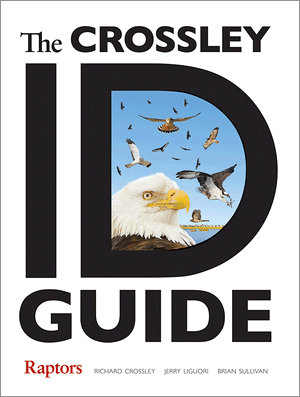Review: The Crossley ID Guide: Raptors
As we have now entered the peak of the hawk migration season along the east coast, there may be no better time to review the latest entry into Richard Crossley’s “ID Guide” series. This one is entitled “The Crossley ID Guide: Raptors” and is authored by Crossley, Jerry Liguori, and Brian Sullivan.
Just like his other recent works, this is a photographic
guide that places as much an emphasis on GISS (General Impression, Size, and
Shape) as it does on plumage features. For more detail on this style, you can
check out my review of his “Eastern Birds” effort.
After a very brief Introduction (5 pages), this book is
divided into two segments: Plates and Species Accounts.
Plates:
The Plates, just like in Crossley’s “Eastern Birds”,
consist of several photos set against a natural landscape background (that
particular species’ preferred habitat). The authors generally do a nice job of
depicting all angles of each age, sex, or color morph of every species. The
more variable a species is, the more photos that species gets. For example,
Zone-tailed Hawk receives two pages of photos while Red-tailed Hawk has ten
pages. The photos are of high quality and look surprisingly true to life – this
is not always the case in photographic guides as sometimes photos can look
obviously “Photoshopped.” I found the plates, with their scenic backdrops, very
pleasing to the eye.
Not all photos are big and beautiful in perfect light. In
fact, most are not. This is important – if you’ve spent any time hawk watching
you know that most raptors are seen from a distance and/or are lit poorly.
At the bottom of each plate lies a few lines of text that
are meant to touch on the main identification points along with a brief mention
of that species’ habits and preferred habitats. Despite the limited space, the
authors do a fine job of including all of the really important stuff (flight
style, shape, and major field marks, etc).
Scattered among the “regular” plates are several Quiz
Plates that depict unlabeled raptors again set against a natural background.
These plates are strategically placed. For instance, after the accipiter plates
comes a Quiz Plate with a bunch of unidentified accipiters scattered across the
sky. Your job is to try to identify these birds. Answers are located in the
back. Now that this guide has been out for several months, I have heard mixed
feelings on the quizzes from folks I have birded with recently. Critics find it
annoying to have to flip to the back of the book to find answers and would
rather the images just be labeled on the page itself, doing away with the quiz
feature altogether. But I actually welcome this sort of thing. It brings a bit
of an interactive element to the table, which adds some fun to field guide
reading (which, I have to admit, can be a bit boring at times). You are even
challenged to age/sex the birds when possible, if you’re up for it.
Though these plates delve into identification of
subspecies and a particular bird’s age or sex, the authors wisely preach
caution while doing so. Subspecific identification, especially of a bird out of
range, can be difficult even under perfect conditions or with killer photos.
It’s not supposed to be easy. Our temptation as birders is to put a label to
every bird we see, but this is not always possible.
Some of these quizzes are meant specifically to replicate
difficult field conditions. There is one particular plate on which every bird
is severely backlit, and another in which birds are tinged orange by the rising
sun. All of these are field conditions you will experience if you spend any
time hawk watching, and this guide will help you prepare for those moments.
There is also a black-and-white quiz which further emphasizes the importance of
structure and plumage patterns; color is so rarely useful while hawk watching
anyway.
Species Accounts:
Each of these begin with a story-like introduction of 2-3
paragraphs, meant to paint a picture of the bird in its typical habitat and
behavior. These are fun and effective. For instance, the Northern Goshawk intro
is particularly entertaining, being written in first person by a hatch-year
goshawk embarking on its first hunt after being pushed from its parents’
territory. These are welcome additions to what is otherwise typically dry field
guide text.
The Accounts are crucial to a raptor ID guide because
flight style must be described so accurately. Without video, descriptive text
is the only way to convey subtle differences in wingbeat frequency, steadiness
in wind, directness of flight, etc. I think the authors did a pretty solid job
with these descriptions. Is the text as descriptive as the classic “Hawks in
Flight” by Dunne, Sibley & Sutton? Not quite up to that level, but still
very useful.
Otherwise, the species accounts do not add all that much
to the identification process. Not that this text isn’t useful, it’s just that the
authors touch on most of the ID points in the small amounts of text at the
bottom of each plate. Each account includes a “Similar Species” section that is
helpful, but again much of that info is repeated from the plates themselves. I
do really enjoy the “Migration” subheading, which informs the reader on where
and when each species migrates, even listing specific hawk watches that one can
visit to see them in spring or fall.
Overall:
There has been quite the glut of raptor ID books on the
market over the past few years, so the consumer has many options from which to
choose. I have read or reviewed most of them, so I have my favorites. Where does
the Crossley guide rank?? Well, IMO “Hawks in Flight” by Dunne, Sibley &
Sutton still stands alone at the top. However this book rates a pretty strong
second, especially for those of you who will be visiting a dedicated hawk watch
site. This book excels in ID of flying raptors. It isn’t as strong for learning
perched birds, but since most raptor encounters include birds in the air, that
isn’t as big a drawback as one might think.
- Nick




Comments
Post a Comment